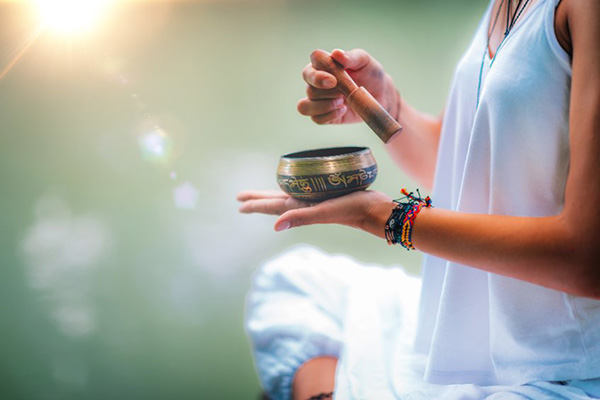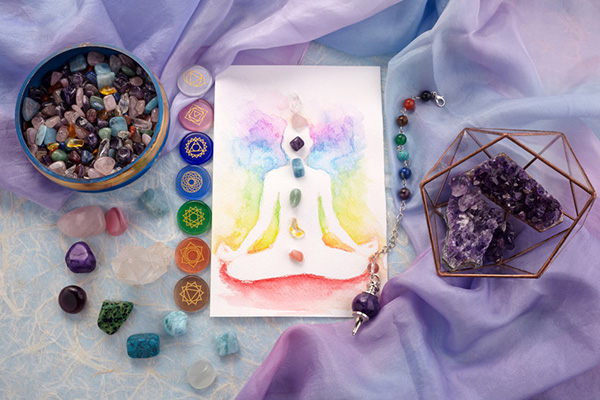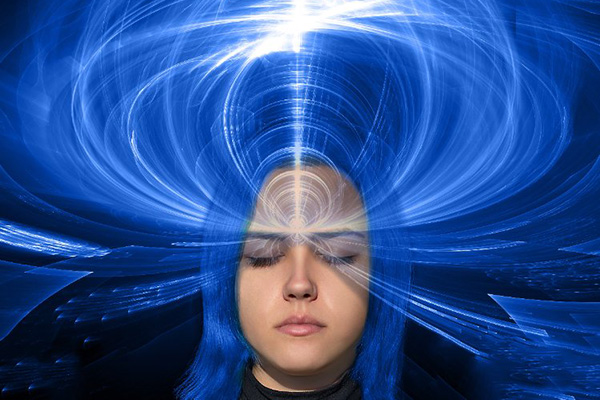mantra
Sound Vibration Heals Our Brain Chemistry
 Thoughts have metaphysical power. Words, speech, singing and sound also have power. Everything we say, sing and chant has vibrational sound frequencies that changes the chemistry of our brain and the physiology of our body.
Thoughts have metaphysical power. Words, speech, singing and sound also have power. Everything we say, sing and chant has vibrational sound frequencies that changes the chemistry of our brain and the physiology of our body.
A positive sound vibration changes the brain to a calm, compassionate, highly intuitive state. Think of a baby laughing and how it brings joy to everyone who hears it.
A negative sound vibration abruptly shocks and damages the nervous system. Think of someone scratching the chalk board or yelling racist epithets, and how both make you nervous and angry.
We can actually improve our health with positive vibrations in the form of mantras. A mantra is a set of words, with a positive meaning that also has a positive vibration. When repeated over and over, this vibration permeates every cell of the body, igniting, healing and repairing these cells. It moves through every muscle, bone and organ.
This process changes the entire energy field, aura, and expands it. Done with enough practice and an open heart and mind it can increase our light to the point where we can heal ourselves or help others to heal.
Have you ever walked into a silent room and felt that there had been a conflict between the people who have been there, before you arrived? That vibration, positive or negative, leaves an energetic residue and is absorbed by everyone entering into it, unless that person has increased their vibration to the point where they become psychically impervious to other’s negative energies.
Growing Your Spiritual Garden
 Many people ask how it is possible to remain positive, fulfilled, and have our needs met during times of crisis, despair, and uneasiness. The answer lies in meditation, creative visualization, belief and the realization that each of us holds the power in our inner being to achieve whatever we set out to do.
Many people ask how it is possible to remain positive, fulfilled, and have our needs met during times of crisis, despair, and uneasiness. The answer lies in meditation, creative visualization, belief and the realization that each of us holds the power in our inner being to achieve whatever we set out to do.
Our lives are not only physical, and emotional, but each of us has a spirit within that can do so much if we allow it to be set free. Sometimes that is not always easy. We, as people, would like to be logical, scientific, have some proof, or have the outcome right away. It is only natural. We are not only brought up this way, taught this way, but also have the brain power to feel a need for logic.
The answer is to let our spiritual beingness loose, to let our inner guidance start working, to start flying over and above the reasonable. Think about your dreams, your ideas, your needs, your hopes as a flower bulb you planted last September. You saw no growth, no movement, no flower, until this month, when the beautiful tulips, hyacinths, lilacs have finally bloomed. This is true belief.
We have no logic to believe a flower will grow from a mere bulb, but it does. That little tomato seed planted in late March is now a leafy green plant, but by late May it should also have some big ripe red tomato fruit on it! Wow, what little miracles we see that have no logic, no reason – they just are.
Today I looked out into a garden where every plant, flower, vegetable I planted was there. Not one did not grow, but they only now started to show up with hope.
The Powerful Magic Inside
 Every human being has powerful magic inside, and part of my job is to teach people how to use that magical energy. I understand the term ‘magic’ is somewhat of a loaded word, so let me re-frame it. Jesus called if faith and told us that with a small amount of faith we can move mountains. Buddha called it thought manifestation and explained that our conscious thought produces our reality.
Every human being has powerful magic inside, and part of my job is to teach people how to use that magical energy. I understand the term ‘magic’ is somewhat of a loaded word, so let me re-frame it. Jesus called if faith and told us that with a small amount of faith we can move mountains. Buddha called it thought manifestation and explained that our conscious thought produces our reality.
How we focus our energy will eventually manifest in one way or another in our lives. For some people this implies ‘darkness’ or ‘evil.’ Darkness does exist, but I believe that it exists only as a catalyst to increase our vibrational frequency if we are ready to do so.
My personal belief is that darkness cannot ‘stick’ if there is nothing for it to stick to. This is why, when discussing lower vibrational frequencies, the best action is to increase your vibration. In my view there is really no war of light versus dark, or good versus evil. We can turn on the lights and then if there is something that needs to be cleaned up, we can clean it up. The darkness does not struggle when the lights come on. It just goes away.
For nearly all problematic circumstances our primary goal should be to change our consciousness and increase our vibrational frequency. It is quite rare that we are we taught to use this magic in everyday life.
There have been many spiritual teachers that have talked about it in the past, as I stated above. Jesus had enough magic (faith) to walk on water and Buddha could exert his magic (consciousness) to tame a wild elephant.
Find Your Calm In Crystals
 It’s been a stressful couple of years for everyone, and stress-relief can be hard to accomplish. Stress, if untreated, can lead to a host of physical and emotional symptoms. But dealing with the stress of everyday life can be made easier with the right crystals in your spiritual practice.
It’s been a stressful couple of years for everyone, and stress-relief can be hard to accomplish. Stress, if untreated, can lead to a host of physical and emotional symptoms. But dealing with the stress of everyday life can be made easier with the right crystals in your spiritual practice.
When starting to work with these amazing crystals and stones, consider this: what causes stress in your life in the first place? Usually, it happens when we feel out of control and our energies aren’t properly centered and grounded. Earth-toned crystals such as smoke quartz (associated with the Earth element for stability) and tourmaline (release of negative energies) bring us to a baseline of positive energies to de-stress.
Soothing colored colors like blue (chrysocolla, aquamarine, lapis lazuli, larimar), violet (rhodonite, amethyst, tanzberry quartz, lepidolite), and white and grey (scolecite, howlite, agate) are traditionally associated with tranquillity and serenity. The cooler hues reflect the elements of water, or emotions, and air, our thoughts.
If you use some of these stress-relieving crystals in your meditations, imagine them help tame the runaway thoughts or feelings which cause so much turmoil. In the chakras, these are the Crown Chakra (thoughts) and Third Eye Chakra (emotions, psychic intuition), which are also represented by blues and purples.
Sometimes stress is less generalized and more related to one specific area in life. Which area is this for you? Knowing will help select the best crystal for your needs. If you’re overcome with panic attacks, amethyst (a well-known stress reliever) or blue sodalite (the Stone of Peace) are good choices.
Perhaps you’re having difficulty with communication at work or in a relationship, so blue lace agate (opening channels) or lapis lazuli (confidence) will work better for you. The possibilities for your crystals are endless: you might want to keep them with you in your pocket, in a necklace or bracelet, or create a special arrangement in your home or office.
The Power Of Deep Breathing
 It is not generally understood how important deep, healthy, mindful breathing truly is. In fact, shallow breathing is linked to all kinds of health problems, including panic attacks, dry mouth, halitosis, cardiovascular issues, fatigue, respiratory problems, and sleep disorders. When we breathe with our chests, we use the muscles in our chests, shoulders, and necks to expand our lungs, which can result in neck pain, shoulder pain and headaches.
It is not generally understood how important deep, healthy, mindful breathing truly is. In fact, shallow breathing is linked to all kinds of health problems, including panic attacks, dry mouth, halitosis, cardiovascular issues, fatigue, respiratory problems, and sleep disorders. When we breathe with our chests, we use the muscles in our chests, shoulders, and necks to expand our lungs, which can result in neck pain, shoulder pain and headaches.
Most importantly, shallow breathing also hinders our immune functioning. The chronic stress and strain it places on the body, results in lower amounts of lymphocyte – a type of white blood cell that helps to defend the body from invading organisms. Shallow breathing actually lowers the amounts of proteins that signal other immune cells. The body thus becomes more likely to acute illnesses.
Deep, diaphragmatic breathing, on the other hand, can lower blood pressure, calm the mind, and improve sleep. It also lowers our heart rate, relaxes muscles, decreases stress, and increases energy levels.
Deep breathing also grounds and centers us. It has been proven to have a profound calming effect on the mind and body. When you are anxious, you take rapid short breaths. When you are content, you take deep, long, full breaths.
The way we breath also affects our mental abilities and thinking. Programming your brain when inhaling can lock thoughts into your memory and can be a powerful tool in our daily spiritual practice. Thinking or saying out loud affirmations like, ‘I am love and light; God and I, me and God are one; I am able to accomplish anything I want; I am powerful;’ will lock those thoughts into your psyche.
Empower Your Life With Ho’oponopono
 I was introduced to the Ho’oponopono prayer several years ago by a friend I met at a meditation group. She told me that it is an ancient Hawaiian custom that can be used to resolve karmic issues in life. So, of course, I tried it, but with mixed results.
I was introduced to the Ho’oponopono prayer several years ago by a friend I met at a meditation group. She told me that it is an ancient Hawaiian custom that can be used to resolve karmic issues in life. So, of course, I tried it, but with mixed results.
It is a simple, yet powerful three-line prayer:
I am sorry. Please forgive me. Thank you. I love you.
I did not fully comprehend it at the time, but even in my lack of understanding, I still experienced some results. Then I reached a point in life where I was experiencing a lot of personal difficulties, and suddenly this simple prayer took on a whole new meaning for me.
It was at a time when I had lost three loved ones in short space of time, and I was going through an intense grieving process and associated life challenges. I figured trying out this prayer again certainly couldn’t hurt. So, for a few days, I made a conscious effort to repeat this mantra in my mind.
I am sorry. Please forgive me. Thank you. I love you.
Then I came across a certification program Ho’oponopono. It is a seminar over multiple days. I had the time and resources to enroll, so it felt like destiny. I then learned a lot more about Ho’oponopono and came to realize it is not nearly as simple as I had originally thought.
The term Ho’oponopono means ‘to make right what is already right.’ The prayer itself is only part of the practice. As a spiritual endeavor Ho’oponopono is about untangling the patterns and blockages that contribute to the challenges we experience in this life. The prayer itself is merely a conduit to experiencing Ho’oponopono, or ‘making right what is already right.’
The Ho’oponopono prayer is intended to move the practitioner into a state of consciousness that is love, free from things like fear, worry, resentment, blame, guilt, criticism, judgment, desire for vengeance, jealousy, and so on.
